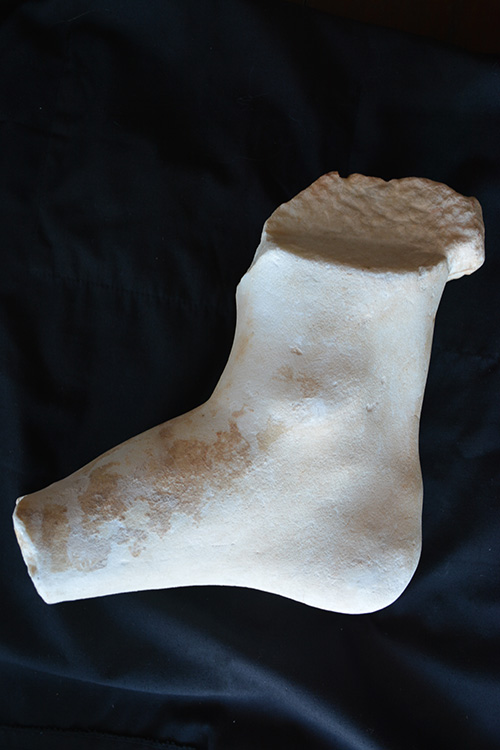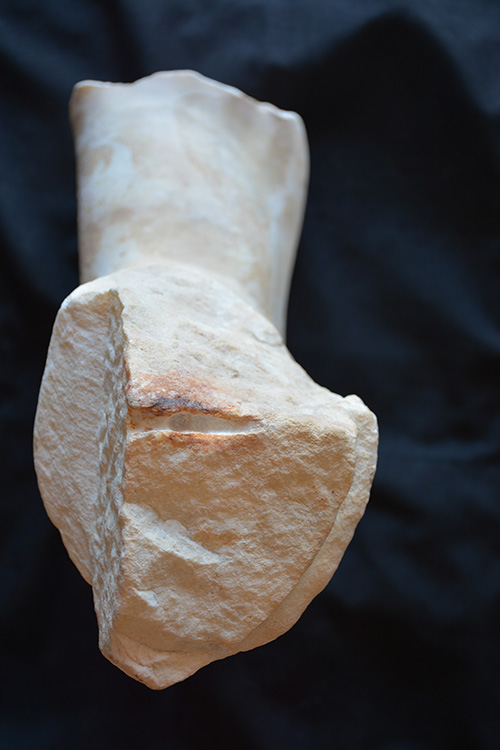Lower part of right leg of a colossal statue
Category
Domus Romana GroupAbout This Artefact
I.D. no: 100612
Dimensions: Max. H. 26 cm. Max. L. 26 cm. Max. W. 14 cm.
Material: Fine grain white marble with honey-coloured patina.
Provenance: The 1881 excavations of the Roman Domus in Rabat, Malta.
Current location: Domvs Romana Museum in Rabat, Malta.
Condition: Only the right foot is preserved from just below the shin down, with a further oblique chip from the break down. On the inner side below the break is a regular vertical cut with a roughened surface below which is another oblique cut with a smoother surface. Another perpendicular cut, with smooth surfaces, is visible also on the opposite side. These, and the surviving half of the section of a horizontal dowel hole with a red iron-oxide stain on top of the break, suggest that the foot was attached separately to the statue. The forepart of the foot with all the toes is missing.
Description: The foot is not covered by a proper shoe with a sole. It is either completely bare or it is protected by a kind of soft leather boot so thin and flimsy as to reveal the modelling of the ankles and the emergent toes. The horizontal protruding strip on top gives the impression of the rolled up upper end of such a boot or stocking, as in a Roman cothurnus. A hardly perceptible vein departs from between the third and fourth toes and climbs up to just above the outer ankle protuberance. This and the barely perceptible emergent toes support the second interpretation.
Discussion:
As there are no traces of points of contact with a base, it would seem that the foot could only be attached to the base from the toes which are missing. This would suggest that the statue to which it belonged rested on the left leg and was on the point of lifting the right foot.
The foot cover recalls many loricate statues, including those of emperors, as well as other mythological figures and personifications represented in several historical reliefs.[1] Most of these, however, have elaborate animal skin boots, with their tops often ornamented with representations of lions’, or other felines’, heads. On the other hand, the Prima Porta statue of Augustus is bare-footed. These comparisons, therefore, do not support this reading.
When one examines more closely the top end of the leg one realizes that the angular cut on the inner side is paralleled by a similar cut on the outer side (as noted above), even if a shallower one. It therefore transpires that the foot was sculpted separately and wedged into the lower end of the right leg. This means that the protruding horizontal element could be simply what survives of the lower end of some type of drapery, including a toga, like the one worn by the sacrificing magistrate in the Census frieze of the so-called ‘Altar of Domitius Ahenobarbus’, and the Aeneas figure on one of the mythological panels of the Ara Pacis.[2] The problem with the togate figures is that they virtually all wear proper shoes (calcei) and until a similarly draped figure wearing an almost transparent footwear is identified, the identity of this leg will remain suspended. There is also the possibility that the foot was originally bare and that the present apparent effect of a semi-transparent cover results from a uniform wear on all the surfaces. The fact that the foot does not display even a hint of a sole seems to support this view. The other possibility is, consequently and given the context, that it belonged to a statue of an emperor in heroic semi-nudity with the lower part of the body covered by a mantle that reached down to below the shins, such as the standing statue of Tiberius or the seated one of Claudius from the Forum of Leptis Magna. [3]
Judging from the style ad workmanship, most probably early Imperial (first-second century AD).
Bibliography: (previous publications of item): Caruana 1881, p. 7 and plate at end of publication: “one leg dressed with a kind of stocking different from the Roman cothurnus”. Ashby 1915, 40: “a leg”. Otherwise unpublished.
[1] See Niemeyer 1968; Goette 1988, passim.
[2] Goette 1988, pls 1. 3 and 6.
[3] Niemeyer 1968.



